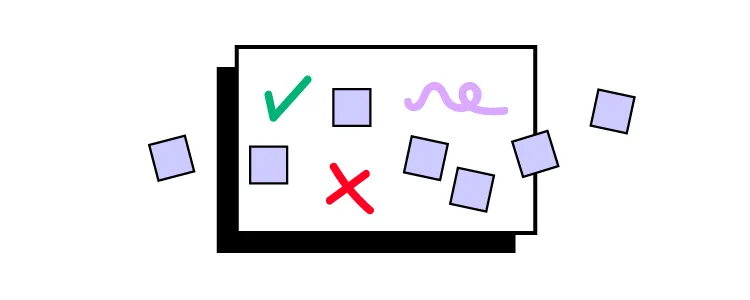Design Team Vision Statement – Definition and Steps

A strong vision statement drives a design team’s actions while contributing to the product and organization’s success. This article explores how to create an effective design team vision statement, understand its purpose, and analyze real-world examples from leading organizations. We also provide a step-by-step framework for developing and implementing your design team’s vision statement.
Align teams with a shared vision and scale design operations with UXPin Merge. For more details and how to request access, visit our Merge page.
What is a Vision Statement?
A design vision statement outlines the long-term goals and desired future state for a product or organization’s design department. It provides designers with a clear direction or “north star” and is a source of inspiration and motivation.
Aligning Vision and Mission Statements
A vision statement and a mission statement combine to provide a comprehensive understanding of an organization’s purpose and direction.
The vision statement outlines the desired future state and long-term aspirations, while the mission statement defines the organization’s core purpose and strategies to achieve the vision. These statements create a cohesive framework that guides decision-making, fosters alignment, and unifies teams toward a common goal.
Importance of a Team Vision Statement

Creating a team vision statement helps establish a foundation for Design’s direction and decision-making processes. An inspiring vision statement encourages teamwork, inspires creativity, and drives innovation by fostering a shared understanding of the design team’s goals and aspirations.
This vision statement anchors the team, enabling designers to navigate challenges and focus on delivering high-quality, user-centric solutions that align with the department’s long-term objectives. When properly implemented, a design vision statement is a powerful tool that fuels the department’s growth and success in line with the company’s mission.
The role of a UX strategy in creating a vision statement
A company’s UX strategy shapes the design vision statement by outlining the desired user experience and guiding design principles. Ideally, a company should establish its UX strategy first, as it serves as a blueprint for the design vision statement, ensuring that the design team’s goals align with the company’s vision statement and broader objectives.
How Design or DesignOps Leaders shape a team vision statement
The Design or DesignOps Leader plays a pivotal role in shaping the vision by facilitating collaboration, fostering a culture of innovation, and guiding the team towards shared objectives. They are responsible for translating the company’s UX strategy into actionable goals, ensuring that the design department’s vision aligns with the company’s values and mission.
Understanding the Purpose of a Team Vision Statement

Aligning goals and values
A team vision statement aligns the design department’s goals and values, ensuring that each team member works cohesively and prioritizes the organization’s overarching objectives while staying true to its core values.
Creating a shared sense of direction
A good vision statement fosters a shared sense of direction by providing a clear roadmap for the team, outlining the desired future state, and inspiring team members to work collectively toward achieving common aspirations.
Guiding decision-making processes
The team vision statement guides decision-making processes within the design department by setting a framework that influences choices and actions, ensuring consistency and alignment with the team’s long-term objectives.
Key Elements of an Effective Team Vision Statement

Clarity and focus
A focused and clear vision statement ensures the concise and effective communication of the design department’s objectives, facilitating a unified effort toward shared goals.
Example of applying clarity and focus: “Empowering our design team to create seamless, user-centric experiences that elevate our brand and inspire customer loyalty.”
Inspirational and aspirational
A compelling vision statement is inspirational and aspirational. It must motivate team members to strive for excellence and establish what the design department seeks to achieve.
Example of applying inspirational and aspirational: “Pioneering innovative design solutions that revolutionize the way users interact with technology, setting new industry standards.”
Reflecting the team’s core values
A vision statement should embody the team’s core values, aligning the design department’s actions and decisions with the principles that define its identity and purpose.
Example of embodying the team’s core values: “Championing empathy, collaboration, and continuous learning as we craft user experiences that are both intuitive and impactful.”
Future-oriented and adaptable
A successful vision statement is future-oriented and adaptable. It enables the design department to navigate evolving market conditions and shifting priorities while maintaining a clear sense of direction and staying true to its foundational principles.
Example of incorporating future-oriented and adaptable: “We are committed to anticipating user needs and staying at the forefront of design trends and technology advancements.”
How to Create a Design Team Vision Statement

Gather insights from team members and stakeholders
The first step is to gather input from team members and key stakeholders. This collaborative approach fosters buy-in and ensures your vision statement considers diverse perspectives. For example, conduct brainstorming sessions or use anonymous surveys to gather insights on team goals, values, and aspirations.
Identify common themes and values
Analyze the feedback to identify recurring themes and shared values that resonate with the team. Look for patterns in the input and highlight aspects that consistently emerge. For example, if team members frequently mention empathy, collaboration, and innovation, these values should inform your vision statement.
Define the department’s purpose and aspirations
Use the themes and patterns from step two to define the design department’s purpose and aspirations. This step involves clearly stating the team’s reason for existing and the desired outcomes they want to achieve through their work. For example, your design department’s purpose may be to create engaging, accessible user experiences that drive customer satisfaction and loyalty.
Craft a concise, memorable statement
Craft a concise and memorable vision statement using the insights gathered that encompass the team’s purpose, values, and aspirations. This statement should be clear, actionable, and easy to remember. For example, “Designing user experiences that delight, empower, and inspire, driven by empathy, collaboration, and innovation.”
Test and refine your vision statement
Share the draft vision statement with team members and stakeholders for feedback. This iterative process ensures your vision statement resonates with the team and organization.
Communicate and implement the vision
After finalizing your design team vision statement, share it with the entire team and integrate it into your daily operations. This step involves incorporating the vision into team meetings, goal-setting processes, and decision-making frameworks. For example, display the vision statement in the team’s workspace, reference it during project kick-offs, and use it as a guiding principle for performance evaluations.
Embedding the Vision Statement into Your Design Culture

Here are some tips for embedding your vision into your organization’s design culture:
- Regularly communicate the vision statement with your team to keep it fresh in their minds. For example, you can start team meetings by recapping the vision and highlighting its relevance to current initiatives.
- Incorporate the vision statement into onboarding and training to ensure all team members are aligned. For example, discuss how the vision shapes the design department’s work and decisions during onboarding.
- Integrate the vision statement into performance evaluations and feedback. For example, discuss how a designer’s work contributed to realizing the vision during performance reviews.
- Celebrate successes aligned with the vision to reinforce its importance. For example, when a project embodies the vision statement’s principles, highlight it during a team meeting and praise the team’s efforts.
Vision Statement Examples from Leading Organizations
IDEO
“We believe a better future is for all of us to design.”
Design teams can learn from IDEO’s vision statement by embracing the idea that creating a better future is a collective responsibility. This statement empowers designers to take an active role in shaping the world around them and emphasizes the importance of inclusive design practices.
IBM Design
“IBMers believe in progress—that by applying intelligence, reason, and science we can improve business, society, and the human condition. Given our scale and scope, good design is not just a requirement, it’s a deeper responsibility to the people we serve and the relationships we build.”
IBM’s vision statement reinforces the importance of leveraging intelligence, reason, and science in their work and understanding that good design is a fundamental responsibility. The statement also highlights the impact of design on both business and society, emphasizing the role of designers in driving positive change.
MUI
MUI’s vision statement focuses on the team’s pursuit of excellence in its tools and processes. This statement highlights the importance of continuously improving and optimizing UI design solutions to serve developers and designers better, ultimately enhancing collaboration and efficiency.
Did you know you can bring MUI components into the design process to create prototypes that look and feel like the final product?
Import any open-source UI library or your company’s design system into UXPin using Merge technology to create a single source of truth across design and development. Learn more by visiting our Merge page.




